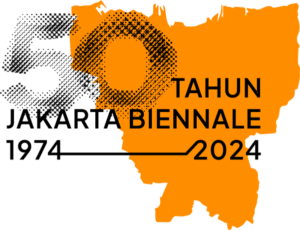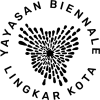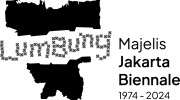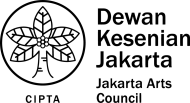Jakarta Biennale merupakan perhelatan akbar seni rupa kontemporer Indonesia yang dilangsungkan setiap dua tahun sekali. Pertama kali digagas oleh Dewan Kesenian Jakarta pada 1974 dengan nama Pameran Besar Seni Lukis Indonesia. Sejak 2009, Jakarta Biennale diselenggarakan dalam skala internasional.
Jakarta Biennale 2024 akan dihelat selama 50 hari untuk merayakan 50 tahun Jakarta Biennale.
Waktu Penyelenggaraan: 1 Oktober – 15 November 2024
Lokasi Penyelenggaraan: Kompleks Taman Ismail Marzuki Jakarta dan ruang-ruang kolektif yang bergabung di dalam Majelis Jakarta.
Majelis Jakarta
Jakarta Biennale 2024 diselenggarakan secara bersama-sama oleh ekosistem seni Jakarta dengan penggerak utamanya adalah kolektif-kolektif seni di Jakarta yang tergabung di dalam Majelis Jakarta.
The Jakarta Biennale is a major event of Indonesian contemporary art which is held every two years. It was first initiated by the Jakarta Arts Council in 1974 under the name of the Pameran Besar Seni Lukis Indonesia (Great Indonesian Painting Exhibition). Since 2009, the Jakarta Biennale has been held on an international scale.
Jakarta Biennale 2024 will be held for 50 days to celebrate 50 years of the Jakarta Biennale.
Organizing Time: 1 October – 15 November 2024
Location: Taman Ismail Marzuki Complex, Jakarta and collective spaces that are part of the Majelis Jakarta.
Majelis Jakarta
The 2024 Jakarta Biennale is being held jointly by the Jakarta arts ecosystem with the main movers being art collectives in Jakarta who are members of the Majelis Jakarta.
MAJELIS JAKARTA
COLLABORATORS
Curating Topography Trilogy
Chief curator: Sandy Hsiu-Chih Lo
“Curating Topography Trilogy” Part I, “Topography of the Mirror Cities,” was conducted from 2016 to 2021 across six cities—Dhaka, Bangkok, Taipei, Jakarta, Cambodia, and Kuala Lumpur—where each urban environment served to reflect and illuminate the others. The upcoming part II, titled “The Glimmer of Artistic Topographies,” aspires to enhance cross-disciplinary collaboration among these locales, aiming to cultivate a more proactive and diverse artistic vision for a shared future and a collaboratively constructed world.
Topography of Mirror Cities
(“Curating Topography Trilogy” Part I)
Curating topography not only acknowledges individual differences but also presents an alternative community discourse. It does not aim to restore the integrity of a place that is lost, but rather seeks to create a fresh space focused on the cultural imagination of the invisible and unclassifiable multitude. The key is to redefine the place as an open art field—a platform for communication and exchange, and a public space that condenses the community’s imagination. It embraces a critical, liberating, and emancipatory concept of time and space, functioning as a heterotopia between reality and imagination. This space calls for the production of relative and relational spaces, dialectically operating within actual living spaces while simultaneously acting upon abstract, immaterial cultural spaces.
SHOHORNAMA I (Dhaka), curated by Rahman Mahbubur
Bangkok Layers(Bangkok), curated by Jiandyin(Jiradej+Pornpilai Meemalai)
Herbal Urbanism(Taipei), curated by Manray Hsu
KOTA.EDU(Jakarta), curated by Ade Darmawan
Currents I(Phnom Penh), curated by Vuth Lyno+Pen Sereypagna
Reshaping: History, Community & Identity(Kuala Lumpur), curated by Yeoh Lian Heng
The Glimmer of Artistic Topographies
(“Curating Topography Trilogy” Part II)
Everyone longs for a sense of belonging to a place and seeks to imagine how to connect with the world from that place. Utopian fantasies and transcending taboos seem to share a similar psychological structure; both are expressions of dissatisfaction with the status quo. In this context, places are presented as seeking to expand the boundaries of life, creating a landscape of constantly changing places. A new life is a new beginning, and everyone has the ability to act and create a unique landscape. At the same time, based on the plurality of new life, there are countless possibilities for the action of weaving landscapes. Weaving landscapes that integrate ethics, politics, and aesthetics is not solely an endeavor to care for the world and enhance the better life; it also embodies the pursuit of humanity’s highest ideals. This represents the profound significance of creating fluid landscapes rooted in specific places. The glimmer of artistic topographies serves as a guiding light along this path.
Taiwan Section
This year, the Jakarta Biennale commemorates its 50th anniversary with a comprehensive artistic celebration, prominently featuring the contributions of Taiwanese curators and artists. Among the highlights of this event, three projects, “Whose City,” “Herbal Urbanism: Jakarta” and “Mobile Topography,” will delve into the intricate historical and contemporary relationships between Taiwan, Jakarta and other cities, while also addressing broader themes of urban interaction and cultural exchange.
Whose City
Curators: Yuma Taru+Sandy Hsiuchih Lo
Artists: Anli Genu, Baunay Watan, Alak Akatuang(Hung-Kun Duan), Walis Labai, Yuma Taru, Aguce, Pilin Yapu, Yulan Toyuw, Mayaw Biho, Hung-Lin Chiu, Anchi Lin(Ciwas Tahos), Bawxin Suyan, Yi-Jen Dou(hewen), Siyat Moses
Herbal Urbanism: Jakarta
Curator: Manray Hsu
Artists: Chao Jui-Kuang, Feng Wei-Chung, Huang Po-Chih, Hsu Cheng-Tang, Melmel Chen, Peng Hung-Chih
Mobile Topography
Artists: Tsai Ming-Yueh+Absence Space(Chen Yu-Ching+Ku Yi-Lin), Jimmy Lin+Yi-Wen Chen+Ryan Chang
SHOHORNAMA II(Dhaka)
Curators: Mahbubur Rahman + Lipi Tayeba Begum
Participants:
Artists: Afia Noor, Aminul Islam Ashik, Amir Faisal Ruscho, Arpita Singha Lopa, Ashim Halder Sagor, Farah Naz Moon , Farhana Ferdausi, Jinnatun Jannat, Mahbubur Rahman , Mahmuda Siddika, Mehedi Hasan, Mohosin Kabir, Mohammed Noman Khan, Sarah Jabin, Shahriar Shaon, Shimul Datta, Shimul Saha, Tamanna Liza
Architects: , Sabiha Ambareen Haque, Samiha Tajrin, Shamim Ahmed Chowdhury, Tabassum Ul Zannat
The Valley of Hope(Kuala Lumpur)
Curator: Yeoh Lian Heng
Artists: Vincent Yeoh Soon Hwa, Tan Cheng Guan, Ching Ooi Chee, Yee Sooi Siam, Lim Booi Nya, Lim Yan Chin, Leong Chee Kuang, Tan Eng Chong, Goh Sooi Seong, Yong Chin Kong, Chuar Gim Tuan, Heng Pak Nang
Project volunteers: Lim Mei Kim, Chong Pow Ying, Ang Tsuey Ing, Yong Lai Chan, Yong Loy Heong, Choo Khai Yan, Ethel Cheah, Choo Chui Wah, Tee Poh Ling, Tammy Yeoh, Yee Yoon Ching, Cheang Ooi Peng, Chia Guat Ching, Heng Chea Kun, Erica Chen, Foo Kah Yan, Lee Bee Teng, Samantha Tang Mae Yee, Chong Sook Fang, Chong Qi Jia, Kam Lok Yan, Lam Che Sum
Documentary film directors: Zijee Chang+Yoeh Ue Jay
Lab Indonesiana: Baku Konek
Residency programs – where artists live for a certain period in a place to work – in the visual arts field are quite well known as a way to enrich the artist’s artistic experience by being in a different socio-cultural and environmental context. However, most artist residency programs are still very focused on the position or self of the artist, not on the relationship between the artist, the host, and the environment or residents in the surrounding area where the residency is located. In addition, in Indonesia, residencies are still often oriented from the perspective of enriching social and personal experiences carried out abroad, not in Indonesia.
With the background of the idea of encouraging artists to have sensitivity, roles and involvement in society and the environment through their artistic practices. That is why a residency program for Indonesian artists in the country that is sustainable and rooted in the diversity of local contexts is needed. This also needs to be balanced with a sustainable program so that the ideas and artistic achievements of artists can expand.
The Artist Collectives in Palestine x Majelis Jakarta: Our People are Our Mountains
At de Appel, Palestinian Assembly have been delving into the intricate and pressing themes surrounding Land, particularly its ownership and use, which are urgent questions at the moment. Land represents the frontline for various critical issues, including the environmental crisis, land grabbing, settler colonialism, affordable housing, and more. In the present context of late capitalism, Land has been reduced to a mere commodity, stripped of its intrinsic value and communal significance. Yet, we witness a surge of political and social movements worldwide that are fervently advocating for equitable access to and restitution of land and its resources. Artists, often at the forefront of these struggles, are not just participants but innovators, exploring and embodying new paradigms of shared ownership and reimagining the commons.
In this exhibition, the artist collectives in Palestine collaborate with Majelis Jakarta by sending instructions remotely. The concept behind utilizing instructions, rather than physically shipping artworks or facilitating travel, stems from ethical, political, and environmental considerations. The art community is increasingly cognizant of the complexities and consequences of travel and the logistics of transporting artworks for brief exhibitions; the environmental cost often outweighs the potential benefits of creating and maintaining relationships. Nevertheless, the importance of maintaining connections, learning from one another’s artistic expressions, and building solidarities across shared struggles remains undeniable.
The act of sending instructions is also a way to point to the physical and symbolic distances, particularly emphasizing the profound difficulties associated with moving in and out of Palestine. This initiative, therefore, is an experiment—artists will transmit their creative directives to counterparts in Jakarta, who will, in turn, realize, perform, or enact the instructions in places works. In the Asmterdam iteration, At de Appel, the instructions will be presented, whereas some parts of them will be activated throughout the coming weeks. Alongside, a programme of performances, workshops and gatherings will accompany the exhibition.



